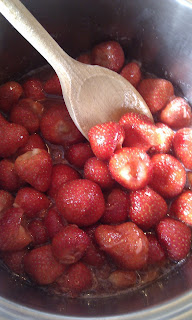Last week was my friend Messner's birthday, which of course means the opportunity to make a cake. Since he hasn't got a particularly sweet tooth, I wanted to avoid frosting, and to stick to a more traditional kind of bake. Flicking through the BBC Good Food guide to Cakes and Bakes for inspiration, I saw this delicious-looking Devonshire Honey Cake. I had to adapt the recipe due to a dearth of the requisite ingredients, but I've been told by a (Devonian) friend who has tried the original that this version makes more of an impact on the tastebuds. So here's my take on a classic....
Ingredients:
250g honey (about half a jar)
3tblsp golden syrup
175g unsalted butter
75g dark muscovado sugar
2 large eggs, beaten
250g self-raising flour
Method:
1. Pre-heat oven to 140-160 degrees celcius, and grease and line an 8" springform cake pan.
2. Cut the butter into chunks, and melt slowly in a pan on the hob with about three quarters of the honey, all the golden syrup and the sugar. One the ingredients are completely meted and mixed, increase the temperature and boil the liquid for about a minute. Set aside to cool for about 10-15 minutes. (If you put a bit of water in the sink then sit the pan in there it will be cool enough sooner).
3. Once, the mixture is cool enough to dunk your finger in for three seconds or so, you will be OK to add the eggs without them cooking. Stir them into the mixture.
4. Sift the flour into a large mixing bowl, then gradually add the honey mixture, beating all the time, until you have a smooth, runny batter.
5. Pour into the prepared tin, and bake for around an hour, until the cake is tanned, well risen, and springs back when you poke it, and when a skewer comes out clean.
6. Put the cake on a wire rack to cool, and after 5-10 minutes, when it is cool enough to handle, gently warm half of the remaining honey (you can do this on the hob, or with about 3 x 10 second bursts in the microwave, stirring in between), and use it to glaze the top of the cake.
7. Leave the cake to cool some more, and for the honey to absorb in. Then warm the last of the honey, and use this to create a second layer of honey glaze on the top of the cake.
This cake is perfect to serve with a nice cup of Earl Grey, but I can imagine it's amaxing served with custard as well. Unfortunately, I forgot to take a picture before presenting it to my friend, and ten minutes later (and despite only four people being present), this was the only picture I could get.....
I suppose that speaks for itself?!






